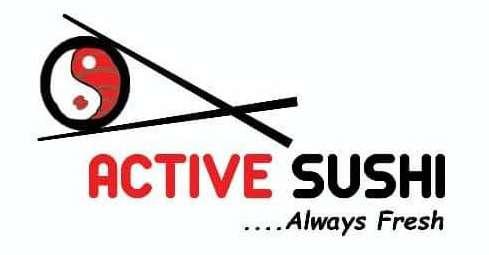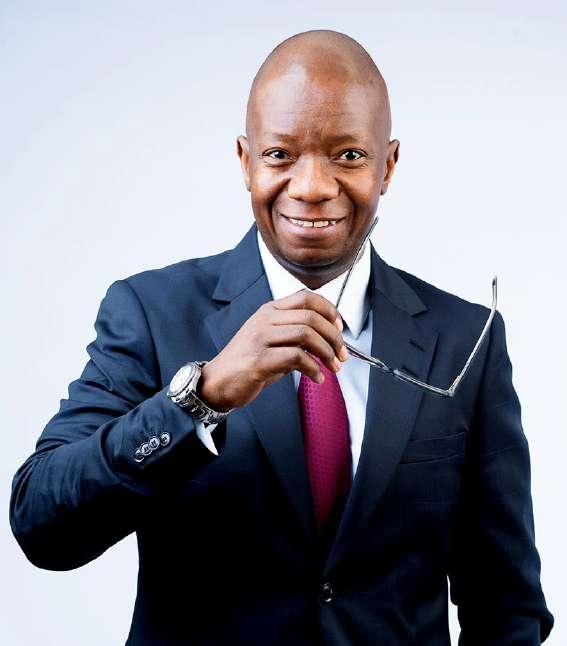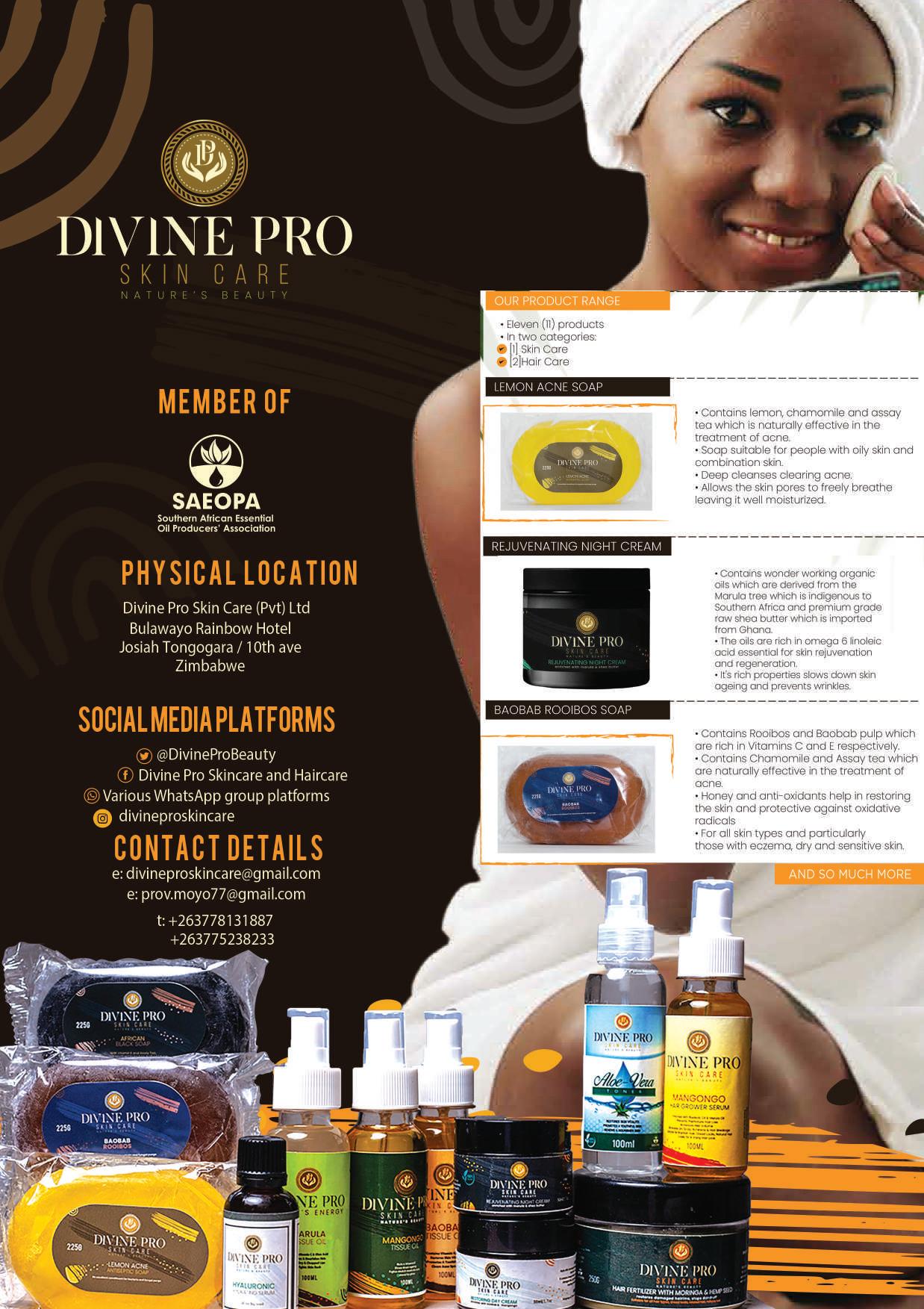




The platform to grow, connect and equip SMME businesses. October - December 2024 - Issue #15
MANAGING DIRECTOR (DIAMOND BERRY ENTERPRISES) Nhlanhla Dabengwa
CHIEF EDITOR
Mellisa Tshuma
EDITORIAL TEAM
Jennings Chibike Khayelihle Sibanda Anittah Munyaradzi Chidonhwe Loveness Mpofu
ADMINISTRATION
Charllote Mpofu Gugulethu Ncube
MARKETING & SALES
Charllote Mpofu
Magazine Design
Arthur Musiyiwa David Papayi
DIAMOND BERRY ENTERPRISES
The Property Center, L Takawira & J Tongogara St, Bulawayo, Zimbabwe.
MARKETING & ADVERTISING
TEL: +263 29 226 2993
CELL: +263 71 570 0593
EMAIL: newsroom.excomag@gmail.com, info.diamondberry@gmail.com
PUBLISHED BY DIAMOND BERRY ENTERPRISES



Exhibitors Corner www.diamondberry.co.zw / www.excomag.co.zw

Melisa Tshuma Chief Editor Excomag

We live in a global village and everyone you will meet will have something that you need or know something that you don’t know. Networking has become a great aspect in our business industry as it opens doors for better enriched ideas from various individuals. It’s about that time again where your favorite publication feeds and nourishes your heart and mind, we hope you will be enthralled by this issue.
Many great leaders will attest that one of the preeminent and most effective ways to develop as a leader is to expand your network, of course it goes beyond updating our Linked-In and all other social media platforms. The upcoming and new entrepreneurs tend to think keeping boxed in their small corner offices protecting their concepts is a great trait of a leader. Little do they know that interacting should be one of your greatest agendas if you want to see yourself grow. Networking is not a stealer of time and finances and should be scheduled like any other activity by a trailblazer. Popular to the saying “if you want to go fast, go alone. If you want to go far go with others”, one should never underestimate where the company of others can lead. Recently we hosted an SME Indaba whose mandate was networking, growing your business and to inspire trough the different stories that are told by the unique speakers at the event. Delve
Delve in to get some indispensable nuggets about financial and legal obligations that you might be missing out in your business
in and read pieces from Zimnat, Keith Heywood and Liquid Technologies amongst other names.
In this issue, we profile Mercy Mabiza who has taken the saying “The question isn’t who is going to let me; it’s who is going to stop me.” To another level. Building a business during the covid era and taking over the industry by storm is testament to her entrepreneurial capacities.
The mix of content here is quite wide and diverse but, as a leader, it is vital to have a wide and diverse range of insight and knowledge. We hope you will find the nuggets here insightful, stimulating as well as valuable in your life and your work. It’s been a pleasure to know how some of these have shaped your journey. For comments and feedback please write to us on newsroom@ excomag.co.zw. Be inspired, be motivated!
Together we will conquer. Be inspired, be motivated!

Nhlanhla Dabengwa MD. Excomag

In Focus:Nhlanhla Dabengwa
As any entrepreneur with a fair share of ambition, curiosity and drive, from as early in my life, I am fascinated by the way some people are able to rise above their circumstances and achieve great things despite their circumstances.
It was not until I discovered personal development that I was able to comprehend the secret to their success, It became evident to me that improving oneself was the key to pursuing our dreams.
In this article, we’ll explore the meaning and benefits of personal development, and how it can help us achieve growth, success and fulfillment in all areas of our life.
Personal development is the continuous process of improving yourself in various aspects of life, including but not limited to career, relationships, health, spirituality, and creativity. It involves taking intentional and strategic actions to overcome limitations, develop new skills, and achieve personal and professional goals that align with your values and passions.
The goal of personal development is to reach your full potential, to live a more fulfilling and meaningful life, and to make a positive impact on the world. Personal development is a life-long journey that requires a commitment to learning, growth, and self-discovery, and can lead to greater happiness, success, and fulfillment in all areas of life.
Personal development is important because it helps you improve your self-awareness, build your skills and knowledge, increase your self-esteem, set and achieve personal and professional goals, and cultivate positive relationships.By investing in personal development, you can enhance your overall well-being, increase your chances of success, and live a more fulfilling life
Personal development is crucial because it empowers you to take control of your life, overcome limitations, and achieve your full potential. Personal development can help you develop self-awareness, identify your strengths and weaknesses, and work towards personal and professional goals that align with your values and passions.
Personal development can lead to greater happiness, fulfillment, and meaning in life, as it allows you to pursue your passions, improve your relationships, and make a positive impact on the world.
Maslow’s hierarchy of needs plays a key role in personal development. According to Maslow, fulfilling basic needs is essential to reach your full potential and self-actualization. TAKE CARE OF YOUR BASICS AND MOVE UP THE STACK.
Personal development can be divided into five categories: mental, social, spiritual, emotional, and physical:
1. MENTAL -Mental development involves exercising the brain and staying mentally fit through activities such as coaching, learning opportunities, and career growth. Mental fitness also requires rest, which contributes to increased resiliency, innovation, and self-awareness.
2. SOCIAL -Social development involves building relationships, learning communication skills, problem-solving, relationship-building, and receiving and giving feedback.
Nhlanhla Dabengwa MD. Excomag
3. SPIRITUAL -Spiritual development involves a deeper understanding of oneself and the world around us. It helps to uncover values and bring greater awareness to self and change.
4. EMOTIONAL -Emotional development is closely tied to emotional intelligence and involves understanding feelings, thoughts, and actions. Emotional development can be fostered through experiences and reflection on personal growth.
5. PHYSICAL -Physical development focuses on nourishing physical health through nutrition, sleep, exercise, and movement. A healthy body supports a healthy mind and emotional well-being
Personal development has several benefits that can transform your life and help you reach new levels. Here are some of the key benefits that come with investing in yourself:
1. Increased Self-Awareness & Self-Esteem — By taking a closer look at your thoughts, feelings, habits, and reactions, you can become more self-aware and boost your self-esteem.
2. Improved Mental Fitness — Developing mental fitness is key to achieving success in all areas of your life. By investing in personal development, you’ll become more productive, resilient, and innovative
3. Greater Resilience — Life is full of ups and downs, but with personal development, you’ll develop greater resilience and be better equipped to handle life’s challenges.
4. Acquiring New Skills & Knowledge — Personal development opens up a world of opportunities for learning and growth. Whether you’re looking to further your career or learn a new hobby, you’ll have access to new skills and knowledge that will enrich your life.
5. Stronger Personal & Professional Relationships — Personal development also has a positive impact on your relationships, helping you to build stronger connections with those around you.
Personal development is a crucial aspect of achieving success, happiness, and fulfillment in life. It is a continuous journey of self-discovery, self-improvement, and growth that requires commitment, discipline, and a growth mindset.
By investing time and effort into personal development, you can improve your self-awareness, develop new skills, overcome limiting beliefs, and achieve your full potential. The benefits of personal development extend beyond just personal growth; it can also lead to professional success, stronger relationships, and a greater sense of purpose and meaning in life. So, make a commitment to invest in yourself and your personal development, and start your journey towards achieving your full potential today.


Nkompon’ Kulture: WHERE STYLE MEETS CULTURE instagram: nkomponkulture_zw | facebook: nkomponkulture_zw

With Dr. Langa Moyo
DR. LANGA. – FOUNDER & DIRECTOR COMRADES BEVERAGES.
The Exhibitors Corner team took a moment to interview and catch up with the witty entrepreneur, academic and leader Dr. Langa Moyo who is the founder and director of Comrades Beverage, a leading beverages company hailing from Bulawayo, Zimbabwe. Maybe lets not spoil the fun and here what he had to say, we hope you will be as inspired as us – Happy Reading!!
EC. Briefly, who is Dr Langa Moyo and Comrades Beverages?
DR. Dr Langa Moyo is a chemical engineer by profession currently a senior lecturer in the department of chemical en gineering at NUST. While Comrades Beverages is a company that was established in 2021 with the intent of handcrafting unique products such as gin rum and juices with an indige nous flair.
EC. •How did you get your idea or concept for your business?
DR. Comrades Beverages, was an inspiration of the covid era, passing time and sitting at home with friends a thought came to us - why can’t we make our own healthy alcoholic drink.?
EC. What then was your mission at the outset/from start after this inspiration?
DR. One of our leading inspiration points was our need to pro duce a healthy beverage that would help out combat diseases such as covid and more, while enjoying while at it.
EC. How Many employees and Partners?

DR. Currently we have 5 employees and 3 partners within the business.
EC. What specific service(s) or product(s) do you offer as a business this far?
DR. We provide tailored mobile bar service for events and the likes, so far we have hosted cocktail events for large corporates such as PRAZ.
I am a proud Zimbabwean. I am a young entrepreneur with a passion for creativity. Comrades Beverages is a place where we have a vision to Inspire through creativity.
Navigating business is not always easy. I rely on God’s Word for direction. The Bible explains many principles about running a business successfully.
EC. Any personal goals in relation to Comrades Beverages?
DR. Our main goal as of now is to see our products hitting the export market within 1 year.
EC. Any Particular Uniqueness about your business/corporate brand?
DR. We produce hand crafted products meaning we pay attention to quality and experience.
EC. Tell us more about your flagship product the Matobo Gin?
DR. The Matobo African gin is a unique handcrafted gin infused with indigenous botanicals that include baobab and zumbani.
EC. To what do you attribute the success of the Gin?
DR. It is the first hand crafted Gin made in Bulawayo and people identified with it and supported it tremendously
EC. The Matobo Gin Festival? What is it all about?
DR. This is a festival held annually to primarily cater for gin enthusiasts, and raise funds for animal conservation in the Matobo National Park.
EC. As a Director of Comrades Beverages, what are your main responsibilities?
DR. Primarily it has been ensuring that we have a good competitive product that we can sell commercially, promote the success of the company and ensure we have a winning team.
EC. What made you choose this line of business?
DR. I started brewing and distilling during my university days I was very passionate about the hobby to a point where I was appointed as team leader of the Wits microbrewing team. https://witsvuvuzela. com/2012/07/27/distilling-a-winner/ link to varsity article.
EC. Does your company help the community?
DR. Yes! We are very much involved in community projects, we have sponsored and supported various young artists in the music industry.
EC. If you had one advice to someone just starting out, what would it be?
DR. “Rome wasn’t built in one day”
EC. What’s in store for Comrades Beverages, Matobo Gin and the festival in the near future?
DR. We are currently rebranding the gin it’s going to be repackaged as well so really exciting times as well, we will be making bottled water and juices by the first
week of September this year.
EC. Your social standing? Do you have a family?
DR. Yes, I do have a family have a wife now looking forward to expanding it to three before end of year lol.
EC. How do you balance work and Family?
DR. They say behind every successful man there’s a woman, my wife has been very supportive throughout the journey and this has made it possible for me to multi task.
EC. Any religious affiliation?
DR. I’m a Christian Anglican to be precise.
EC. Any proud moments yet in your journey as Comrades Beverages?
DR. Oh yes, very much so the latest one this far was the Eagles nest second runner up 2023. Under the ZimTrade Youth program that was aired on television.



Legacy Mushrooms is a Zimbabwean brand that offers a range of skincare products that are made from natural and mostly organic ingredients infused with mushroom extracts. No harsh chemicals, no synthetic fragrances or dyes. At Legacy Mushrooms, they believe that what you apply on your skin should be safe for consumption.
Mushrooms are known to have several health benefits such as:
• Rich in vitamins and antioxidants for skin protection.
• Antibacterial properties reduce breakout.
• Boost the production of Collagen leading to vibrant and youthful skin.
• Hydrate and moisturizes the skin which is a simple and healthy way to boost skin complexion.
• Anti-inflammatory properties to help improve inflam matory skin conditions such as eczema and psoriasis
CONTACT
+263 777954460
Legacyshrooms@gmail.com
Facebook: Legacy Mushrooms
Instagram: Legacymushrooms_zw



Natasha Chiedza is one emerging content creator, brand ambassador and social media influencer of note in the city of Bulawayo. We had the pleasure of engaging with her on her exciting career which she is setting off pretty solid and well, here is an up close and personal conversation we had with her!
• What drew you to become a brand ambassador, and how has this role evolved throughout your career?
In all honesty, I just started as a content creator. Growing up, I had always admired different advertisements that I would see on TV and I knew that I was capable of doing that as well, however no opportunity had availed itself then. As time went by, I started reaching out to companies and brands to no avail. I then elected to start creating my own content by going to different places and, you know, I would start eating and vlogging different things (with consent, of course.) From there, people started recognizing and believing in my work.
As time went on, I actually had the privilege of becoming an ambassador for different companies and people approached me because they saw that I am actually passionate about what I do. In terms of evolving, I have only been doing it for close to a year and in all honesty it’s hard to really see a difference in evolution yet, however I have managed to upskill myself in editing skills and my confidence levels have also gone up due to the competence I have managed to obtain.
• Can you share a memorable moment or campaign that really showcased the power of brand ambassadorship?
Being appointed an ambassador for Munch & Sip, which is the biggest food festival that happens in Bulawayo was definitely a major highlight that I have had this past year. It is an event that was founded by Mandipa Masuku and my appointment was so memorable in the sense that it gave me more exposure and the opportunity to connect with different people from all spheres. I learnt a lot about event planning, how things happen behind the scenes and most importantly it put my name out there and that there is power brand partnerships. In addition, I have also gained an amazing family at Munch & Sip.
• How do you ensure that the brands you represent align with your personal values and public image?
I haven’t really been doing this for long yet, however I think honesty is usually the best policy when interacting with brands. Pointing out areas of concern in partnerships and openly discussing avenues to explore so that both the brand, its product and services are better portrayed in the best possible way without compromising my personal core values and what I stand for. So, I think a lot of open and honest communication throughout is healthy.
•In your experience, what are the key elements that make a brand-ambassador relationship truly successful?
In my honest opinion, firstly authenticity. Just be authentic as an ambassador. DO YOU. Each one of us has their own modus operandi, be as authentic as possible do not try to be something else. Secondly, confidence! You need to be very confident in yourself, when you’re addressing people because if you seem unsure of yourself, people will not really have much faith in you or the brand you representing. Lastly you need to be diligent and hardworking, slacking has never got anyone anywhere & the more work you put in the more opportunities that come by as well. You will then meet the right brands that align with your persona and more.
•How do you balance authenticity with the strategic goals of the brands you represent?
I think it all goes back to original agreements between myself and the brands and our desired goals. As a brand ambassador I know my strengths and I highlight them to the specific brands how best to use them for any campaign I engage in so as to remain true to myself. I push myself sure but not at the risk of compromising my work, authenticity and the brands I represent. I believe in being open and honest from the onset and striking a fair balance for favourable outcomes for all.
•Can you describe a challenging situation you’ve faced as a brand ambassador and how you navigated it?
Mostly it has been people’s opinions or feedback. Sometimes not everybody is going to share the same views and experiences as you and you also have to learn and accept as an ambassador that people are entitled to their own opinions. It is possible that my experiences as an ambassador at times are not always the same as other people’s experiences with a particular product or service. You need to keep an open mind that people will have different experiences and opinions about a particular thing be it a product or a place and that feedback is important to both me and the brand I will be representing
A pitch deck can give businesses and entrepreneurs a detailed but concise snapshot of their company to attract investors

... Understanding the necessary elements of a successful pitch deck can help bring you one step closer to the funding you need.
A standout pitch wins customers and partners by defining a company’s value-add, showing proof of concept, and clearly describing how it outshines the competition. In this article, we will break down the core pillars of building an eye-catching pitch deck that will turn heads.
To effectively outline your pitch, it’s important to put yourself in the investor’s shoes. What are the core pieces of information you would need before investing in a company?
Winning decks always have the following factors covered:
• The problem and market opportunity
• Your solution and why you’re better than the competition
• Why your company is worthy of an investment
There are several important components to include in your deck. A good starting point is to follow the Lean Canvas model to ensure that you’ve covered problems, solutions, key metrics, and competitive advantages in three core slides.
And remember, your pitch deck will evolve as your company becomes more mature and you move from seed funding into Series A, B and C
funding rounds.
Start by highlighting the problem at hand in a clear and compelling manner. Create a clear narrative that will resonate with your audience and create a lightbulb moment. A problem statement should introduce tension in the market that you have a quick solution to solve.
When crafting your problem statement, you should focus on the potential side effects of it being left unresolved.
Take time to get your solution statement right. The shorter and sweeter your fix is, the more memorable it will be for investors. Often founders are too close to their product to hone in on one core value proposition. In this case, step away from the details and look to focus on what makes your customers most satisfied.
Before jumping too far into the details, it’s essential to show that there is a pathway to profit. Investors want to quickly understand the scale of the problem and the market potential. Set the stage by developing three core personas that wrap into one larger market segment, each bringing a unique angle for your product. To achieve this, create a slide view of the market size and opportunity.
Once you have offered your problem, solution, and how you fit in – show your audience how exactly you will execute your idea. This section of your deck is where you begin to win investors. Make your business model clear by sharing:
•Business structure
•Gross revenue
•Pricing models
•Profit margins
•Marketing and sales plans.
When it comes to competition, it’s important to show that there’s no one quite like you. An effective way to do that is to go back to the problem statement to remind your audience that you have the best solution for it.

Excomag

Once you’ve defined the competitor landscape in the market, introducing your team can be an excellent way to back up your track record for success. Be sure to showcase the strengths and successes that your team, investors, customers, or partners bring to the table. A track record of success will always make it easier to raise funds.
Seasoned investors want to be sure that founders have a good grasp of their market and product. In fact, investors often use projections to ensure that founders understand their market and numbers well enough to be worthy of sustaining an investment.
Asking for funding is the point in your presentation where you must wrap all the pieces into one compelling ask. Go into the funding request with a clear and precise number. You should be able to deftly detail exactly how you landed at your request valuation, the ways it will support the business, and the results the capital infusion will produce.
The core formula for a winning deck is to focus on telling your story in four to five of your slides. For most founders, this can feel impossible due to how close they are to their product. Throughout the process, remember the basics: keep it simple, make it memorable, and include a clear call to action. Keep your design clean and your text free of jargon. Always review your deck to be sure you’ve included the eight key components of a killer pitch deck, as listed above.




... As a small business owner, understanding the concept of business insolvency is crucial for your financial health and long-term success.
This article will walk you through the key aspects of insolvency, its causes, legal implications, and strategies for prevention and recovery.
Business insolvency occurs when a company is unable to meet its financial obligations as they become due. This can happen even if the business has valuable assets but lacks the liquidity to pay debts on time.
Several factors can lead to business insolvency:
1. Cash Flow Problems — Inadequate cash management or unexpected expenses.
2. Market Changes — Shifts in consumer behavior or increased competition.
3. Economic Downturns — Recessions or industry-specific crises
4. Poor Financial Management — Lack of budgeting or overspending
5. Rapid Growth — Overexpansion without proper financial planning
When a business becomes insolvent, several legal procedures may come into play:
• Voluntary Administration : A process where an external administrator is appointed to assess the company’s financial position and future viability.
• Liquidation : The process of winding up a company’s affairs, selling its assets, and distributing the proceeds to creditors.
• Receivership : Appointment of a receiver by secured creditors to recover outstanding debts.
• Receivership : Appointment of a receiver by secured creditors to recover outstanding debts.
It’s crucial to seek legal advice early if you’re facing financial difficulties. Find a business insolvency lawyer near you https://www.example.com/find-insolvency-lawyer
Insolvency affects various parties:
• Employees : May face job losses or delayed wages
• Creditors : Risk not receiving full payment for goods or services provided.
• Customers : Might lose deposits or face service interruptions.
• Business Owners : Personal assets may be at risk, especially in sole proprietorships or partnerships.
If your business is facing insolvency, consider these recovery strategies:
6. Debt Restructuring — Negotiate with creditors to modify payment terms.
7. Asset Sale — Sell non-essential assets to improve cash flow.
8. Cost Cutting — Reduce expenses without compromising core operations.
9. Seeking New Investment — Look for investors or partners to inject capital.
10. Business Turnaround Strategies — Implement operational changes to improve profitability.
Proactive measures can help prevent insolvency:
• Regular Financial Health Checks : Monitor key financial indicators regularly.
• Cash Flow Management : Implement robust cash flow forecasting and management systems.
• Diversification : Spread risk by diversifying your product/service offerings or customer base.
• Professional Advice : Consult with financial advisors or accountants regularly.
• Continuous Market Research : Stay informed about industry trends and adapt accordingly.
Understanding business insolvency is essential for every small business owner. By recognizing the signs early and taking proactive measures, you can protect your business from financial distress and ensure long-term sustainability.
Remember, if you’re experiencing financial difficulties, don’t hesitate to seek professional advice. Early intervention can make a significant difference in the outcome of your business’s financial challenges.

Excomag
As an entrepreneur with a few years under your belt, you’re no stranger to pressure. But when it comes to team management, the heat can sometimes feel unbearable.
Let’s dive into some practical strategies to help you not just survive, but thrive in this high-stakes environment.
Picture this: It’s 2 AM, and you’re staring at your laptop screen, juggling client demands, financial projections, and a looming team meeting. Sound familiar? You’re not alone. The entrepreneurial journey is often a pressure cooker of responsibilities, and team management can be the toughest nut to crack.
1. Breaking Down Communication Barriers
Communication issues can turn your dream team into a nightmare. Here’s how to break through:
• Daily Stand-ups : Start each day with a quick team huddle. It’s amazing how a 15-minute check-in can align everyone and nip potential issues in the bud.
• Open Door Policy : Encourage your team to approach you with concerns. Remember, an open door is more than just a physical concept – it’s a mindset.
2. From Conflict to Collaboration
Conflict doesn’t have to be a dirty word. Here’s how to turn it into a catalyst for growth:
• Active Listening : When tensions rise, pause and really listen Often, the root of the conflict lies beneath the surface.
• Mediation Skills : Develop your ability to mediate disputes. Sometimes, being a neutral party can help team members find common ground.
3. Igniting the Motivational Spark
A motivated team is a productive team. Try these techniques:
• Personalized Incentives : One size doesn’t fit all. Discover what drives each team member and tailor your motivational strategies accordingly.
• Recognition Programs : Implement a system to regularly acknowledge and celebrate individual and team achievements.

4. The Art of Delegation
Letting go can be tough, but it’s crucial for growth. Master delegation with these tips:
• Skills Assessment : Regularly evaluate your team’s strengths and assign tasks accordingly.
• Trust-building Exercises : Organize team-building activities that foster trust and collaboration.
Time Management: Your New Best Friend
Time is your most precious resource. Guard it fiercely:
• Time Blocking: Allocate specific time slots for different tasks. Stick to these blocks as if they were client meetings.
• The Eisenhower Matrix: Prioritize tasks based on urgency and importance. Learn more about the Eisenhower Matrix https://www.eisenhower.me/eisenhower-matrix/
Seeking Mentorship: You Don’t Have to Go It Alone
A good mentor can be a game-changer:
• Network Actively: Attend industry events and join entrepreneurial groups to find potential mentors.
• Virtual Mentorship: Don’t limit yourself geographically. Go out there and consume much needed information and connect with coaches online.

Picture this: You’re the captain of a small but mighty ship, navigating the turbulent waters of the business world. Your crew - employees, investors, and stakeholders - are looking to you for direction. How do you ensure everyone’s on the same page, working towards a common goal? The answer lies in corporate governance, and for small and medium-sized enterprises (SMEs), it’s the compass that can guide you to calmer seas and greater success.
The Transparency Advantage: More Than Just a Buzzword
When we talk about corporate governance in SMEs, we’re not just throwing around fancy terms. At its core, it’s about transparency and disclosure - being open and honest about how your business operates. But why is this so crucial for SMEs?
“Transparency is the currency of trust in the business world.” - Anonymous
CHALLENGES.
Let’s face it, implementing robust governance practices isn’t a walk in the park for SMEs. You’re likely facing:
Limited resources : Every penny counts, and dedicating funds to governance might seem like a luxury.
Lack of expertise : You’re an expert in your field, but governance?
That’s new territory.
Stakeholder expectations : Balancing the needs of employees, investors, and customers can feel like a juggling act.
Regulatory compliance : Keeping up with changing laws and regulations? It’s enough to make your head spin!
But here’s the thing: these challenges are not roadblocks; they’re opportunities for growth.
BENEFITS.
Embracing transparency in your SME isn’t just about ticking boxes. It’s about unlocking a treasure trove of benefits:
Investor confidence : When you’re open about your operations, investors are more likely to trust you with their capital. It’s like shining a light on your business, inviting others to see its true value.
Access to capital : Need funds to grow? Transparent SMEs are more attractive to lenders and investors. It’s your ticket to unlocking new opportunities!
Enhanced reputation : In a world where trust is currency, a reputation for transparency is worth its weight in gold. It’s not just about looking good - it’s about being good.
Ready to steer your SME towards better governance? Here are some practical steps to get you started:
1. Create a clear organizational structure : Define roles and responsibilities. Who’s at the helm? Who’s manning the sails?
2. Implement regular reporting : Keep stakeholders in the loop with consistent, clear communication. Think of it as your business’s regular weather report.
3. Develop a code of ethics : Set the standard for behavior in your organization. It’s your North Star, guiding every decision.
4. Engage with stakeholders : Listen to your crew. Their insights can help you navigate choppy waters.
5. Invest in training : Equip yourself and your team with the knowledge to implement good governance practices. It’s like upgrading your ship’s navigation system.
Implementing transparent corporate governance in your SME isn’t just about compliance - it’s about setting your business up for longterm success. It’s about building trust, attracting investment, and creating a reputation that precedes you.








Excomag

... As a small business owner, you’re constantly juggling tasks, chasing deadlines, and seeking ways to stay ahead...
What if I told you there’s a game-changing tool that could revolutionize your productivity? Enter Artificial Intelligence (AI) – your new digital assistant and productivity powerhouse.
AI isn’t just for tech giants anymore. It’s a accessible, powerful ally for entrepreneurs like you. Imagine having a tireless assistant that works 24/7, handling repetitive tasks, analyzing data, and even predicting trends. That’s the magic of AI.
The most exciting benefit? Skyrocketing productivity. Here’s how:
1. Automation of routine tasks : AI can handle everything from email sorting to appointment scheduling, freeing up your valuable time.
2. Data analysis at lightning speed : Make informed decisions
faster with AI-powered insights from your business data.
3. Personalized customer service : AI chatbots can handle customer queries round the clock, improving satisfaction and retention.
4. Streamlined operations : From inventory management to workflow optimization, AI can identify inefficiencies you might have missed.
Embracing AI doesn’t mean replacing human creativity – it means amplifying it. By offloading time-consuming tasks to AI, you can focus on what truly matters: growing your business and nurturing your entrepreneurial vision.
Ready to supercharge your productivity with AI? Start small, experiment, and watch your efficiency soar. The future of entrepreneurship is here, and it’s powered by AI.


DR McLean Sibanda

Eric Ries defines a start-up as a very risky venture operating under conditions of extreme uncertainty to validate a business model.
As such, funders are generally aware of the risk and the high failure rate of most startups. Accordingly, funders set their own evaluation criteria dependent on their risk appetite and ability to help the start-up navigate the runway during the funding round. It is important to also mention that although some aspects of what is discussed in this article may be applicable to small medium enterprises (SMEs), there are differences mainly arising from the fact that not every SME is a start-up, a matter I delved into in the last article and Vusi Thembekwayo has written an excellent article in this regard.
So, what in essence do funders look at or at least should look at when considering whether or not to fund a start-up? This article is based on my experience as part of funding teams based on having spent over eight years at the Innovation Fund, PlantBio and Technology Innovation Agency (TIA) reviewing funding applications of nascent ideas from start-ups and consortia (academic and research organizations and private sector, incl. SMEs). Here are some of the key thing’s funders consider when funding a start-up.

The funding application or the pitch must be clear on the problem statement and the technical feasibility of the proposed solution (in other words, the innovation being punted, considering that it is only an innovation once it is in the market addressing a problem or unlocking an opportunity). More particularly, the funders will probe whether or not the science makes sense. By the way perpetual motion inventions are something that funders do not even proceed beyond this part of the pitch – because they defy the laws of science.
On the technical feasibility, they will look for evidence of the extent to which this has been demonstrated (typically a Minimum Viable Product (MVP) or field tests / pilots). Where there is an MVP or field tests / pilots undertaken, the application must be clear regarding what the next step of the Idea is – in essence what will the funding being applied for be used for to progress the idea. Typically, this may include scaling – there are challenges typically of scaling up and in some cases, the science or reproducibility of the results becomes challenging.
The application must be clear on who the customer is or different types of customers (customer segments), and in particular the size of the market. It is of no use to say that the market is the entire population of Africa. You have to be specific in relation to the problem that you are addressing, other players already in the market or the way that the customers are currently addressing the problem, and what you can possibly do or achieve perhaps over a period of five years. Funders will look at the scalability outside local environment into other countries, for example. Other things to be considered are the barriers to entry, including regulatory and intellectual property (freedom to operate) hurdles. Based on assessment of the market, the investors determine their ability to get a return on their investment (ROI).
In most cases, there is an ROI that the proposal must meet. In respect of customers, customer validation in the form of sales or commitments to orders does play an important role in decision making – and hence the importance of an MVP to get customer feedback.
Funders want to know who else is solving this problem, what are the current options and solutions available to the customer, and more particularly why the customer will switch to the proposed idea. In the event that the customer embraces the proposed idea, what is the likely response of the competition? This may be a price war which a well-established customer with good distribution channels and a strong brand may possibly sustain long enough for the starup to fail. In other cases, the customer may poach key personnel from the start-up or try acquire the start-up. One thing that entrepreneurs should not say when talking to funders is that there is no competition – because there is always a way that a customer is meeting their needs or addressing the problem albeit in efficient or
costly – that is competition. So, it is important that an entrepreneur thinks carefully regarding who the competition is and more clearly distinguishes their offering to that of the competition.
A question that funders will invariably ask is what makes this idea unique compared to everything else, in particular the competition. We have already spoken about the response of the competition to the market entry – and therefore critical is an assessment of how the start-up will ward off competition. Where the idea is a subject of intellectual property (IP) protection, particularly in the form of patents, designs, trade secret, and copyright, the funders will assess the quality of the IP protection. Typically, they will look at whether there are granted patents or not, patent search and examination reports of any applications being processed, countries where patents are granted or applied for and whether there is an alignment with the anticipated markets or manufacturing nodes.
Perhaps this is the most important of all criteria, as I have seen funders walk away from a brilliant idea because of a questionable team. In most cases the question is whether the team has all the requisite skills to take the idea to the market and successfully pivot should the need arise. In the case of a very technical or scientific idea, funders want certainty that they will be investing in an appropriately qualified, skilled and experienced team that understands the science and also the business aspects related to commercialization of the idea. It does help when the team is able to demonstrate that some of the founders have done this before, i.e. launched an entrepreneurial venture or been part of a start-up, even if they have been unsuccessful with other ideas in the past. Funders often will assess what might have gone wrong with past failed ventures and whether the founders learnt any lessons.
Unfortunately, my experience is that in some cases past failures may work against the start-up, owing to some funders not having enough experience working with start-ups – it does require a high degree of discernment to make a call on past failures. There is an adage in funding circles that – “I would rather fund a bad idea backed by a strong team than a good idea with a weak team.” So, the main assessment is the capacity of the team to make something meaningful with the idea and where the start-up needs to be at the end of the funding round applied for; and their ability to pivot should the need arise.
As I was finishing writing this, it dawned on me that perhaps the best starting point for any start-up in preparing a funding application or pitch would be to do a comprehensive Business Model Canvas (BMC). This can be done on a one-page and refined a few times and in my experience, helps with clarity of the business model and clear articulation of the value proposition – why this idea is worth looking at. Through the nine components of the BMC, one is able to at least start the thinking process around the five key considerations I have dealt with above









